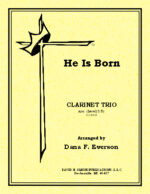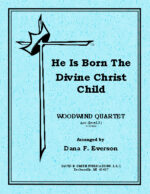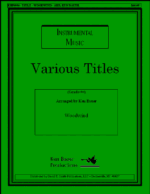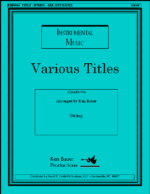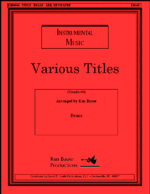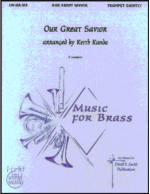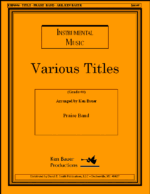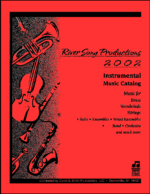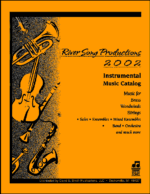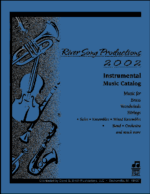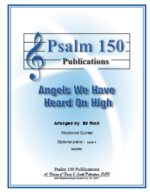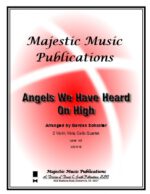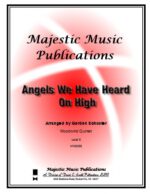-
He Is Born
$8.00Joyful! Joyful! Joyful! This constantly bubbly piece makes a point of the excitement of the Birth of Christ. Although the shapes of the lines constantly change the drive to the end is always present. Rejoice!
-
-
He Is Born The Divine Christ Child
$9.00A woodwind quartet score for two flutes, two clarinets and piano in a jubilant fashion. The piece starts out with a flute solo then in flute/clarinet responsorals. The piece continues to gain more flavor through rhythmic activity leading up to an exuberant ending.
-
Sing, We Now Of Christmas
$6.00This beautiful Christmas carol has been a source of inspiration since the late 15th Century. Originally called ‘Noel Nouvelet’, it became a worldwide favorite early in the 17th century and has remained popular ever since. While retaining all of the
-
Sing, We Now Of Christmas
$6.00This beautiful Christmas carol has been a source of inspiration since the late 15th Century. Originally called ‘Noel Nouvelet’, it became a worldwide favorite early in the 17th century and has remained popular ever since. While retaining all of the
-
Sing, We Now Of Christmas
$6.00This beautiful Christmas carol has been a source of inspiration since the late 15th Century. Originally called ‘Noel Nouvelet’, it became a worldwide favorite early in the 17th century and has remained popular ever since. While retaining all of the
-
Sing, We Now Of Christmas
$6.00This beautiful Christmas carol has been a source of inspiration since the late 15th Century. Originally called ‘Noel Nouvelet’, it became a worldwide favorite early in the 17th century and has remained popular ever since. While retaining all of the
-
Sing, We Now Of Christmas
$6.00This beautiful Christmas carol has been a source of inspiration since the late 15th Century. Originally called ‘Noel Nouvelet’, it became a worldwide favorite early in the 17th century and has remained popular ever since. While retaining all of the
-
Sing, We Now Of Christmas
$6.00This beautiful Christmas carol has been a source of inspiration since the late 15th Century. Originally called ‘Noel Nouvelet’, it became a worldwide favorite early in the 17th century and has remained popular ever since. While retaining all of the
-
Sing, We Now Of Christmas
$6.00This beautiful Christmas carol has been a source of inspiration since the late 15th Century. Originally called ‘Noel Nouvelet’, it became a worldwide favorite early in the 17th century and has remained popular ever since. While retaining all of the
-
Sing, We Now Of Christmas
$6.00This beautiful Christmas carol has been a source of inspiration since the late 15th Century. Originally called ‘Noel Nouvelet’, it became a worldwide favorite early in the 17th century and has remained popular ever since. While retaining all of the
-
Sing, We Now Of Christmas
$6.00This beautiful Christmas carol has been a source of inspiration since the late 15th Century. Originally called ‘Noel Nouvelet’, it became a worldwide favorite early in the 17th century and has remained popular ever since. While retaining all of the
-
Sing, We Now Of Christmas
$6.00This beautiful Christmas carol has been a source of inspiration since the late 15th Century. Originally called ‘Noel Nouvelet’, it became a worldwide favorite early in the 17th century and has remained popular ever since. While retaining all of the
-
Angels We Have Heard On High
$9.95This unaccompanied clarinet quartet is based on a traditional Christmas carol. The arrangement is from the teaching files of Monty Budahl and is useful for vesper, offertory, and special. This arrangement of the hymn tune will provide an interesting variation passing the melody between the flutes with contrasting harmonies after the offset entrances. There is a two page score and a part for each player.
-
-
Angels We Have Heard On High
$30.00Set in a 5/4 time ala “Take Five”, this praise band Christmas arrangement may be performed with as few as 4 players (Trp, A. Sx, Tbn, Pno) yet expands to include a full band (3 Trp, 2 A. Sx, T. Sx, Bari Sx, 3 Tbn, Pno, Bass, Gtr, Organ)
-
-
-
-
-

